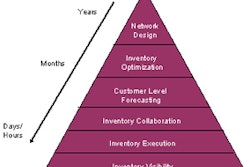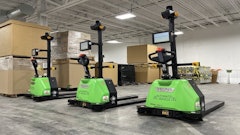By Editorial Staff
At a time when many wholesale distributors are cutting costs, instituting layoffs, freezing wages and just not spending any money, Bardon Supplies Limited decided that if it is to survive the current economic downturn it must focus on two key areas in its supply chain, its customers and its warehouse.
Many distributors will tell you that it's crazy to talk about investing in your warehouse during times like these. But in 2005, after the company was purchased by Group Deschenes, Barry Raycroft, vice president and general manager of Bardon Supplies, picked up where his now-retired father, Don Raycroft, left off. Don founded Bardon in 1969 in Belleville, Ontario, with a small building and a desire to provide the industry what it desperately needed: unmatched customer service. Forty years later, with Don's son at the helm, Bardon Supplies is a full-line, stocking, wholesale distributor of plumbing, HVAC and industrial pipe, valves and fittings, and Barry Raycroft's motto and vision are similar to his fathers.
Therefore it was not out of character to address the one area that has such a dramatic impact on service levels and customer satisfaction, the warehouse. In 2007 Bardon commissioned Total Logistics Solutions, Inc. to assist with the implementation of an industry-leading warehouse management system in the company's Barrie location. Rene' Jones, the founder of TLS, was already familiar with Bardon since he had been the project manager during two previous WMS implementations in the company's Belleville and Kingston locations.
The Barrie branch is approximately 30,000 square feet and has 13 warehouse employees and five delivery drivers. According to Wayne Buck, the branch manager in Barrie, "It was not a question of whether we were meeting our customers' needs, it was a question of, could we meet them more efficiently while simultaneously reducing our warehouse operating costs?"
"Amazing Accuracy"
The implementation of the system was completed in February 2009 with a wall-to-wall physical inventory. "We have always taken our annual physical inventory serious, but this was one of the most in-depth inventories I have ever been involved with," said, Mike Brymer, the warehouse's inventory control specialist.
On the Sunday following the completion of the Saturday inventory, the warehouse began receiving, picking, packing and loading orders with the new system. There were the usual reservations from customers and employees, but the implementation went flawlessly. Customers at the will call counter immediately began asking how their order would get picked without a pick ticket, as the warehouse now uses radio frequency (RF) devices to process all transactions.
As product arrives on the dock, an advance shipment notification (ASN) is generated that selects the most appropriate locations for the product prior to it being touched by the receiving department. "It is great!" said Warren Symes, the lead receiver, adding: "I am amazed at the accuracy. It has virtually eliminated receiving errors, especially with serial numbered product. Before we had to read the tiny numbers on the packing slip and then verify those numbers to the number on the box. Now we just scan the product and the system knows if that is the serial number it was expecting. If it is not, we cannot proceed."
The picking process has been streamlined as well. The order pickers no longer pick an order from start to finish. The orders are broken down into smaller, more efficient chunks based on the type of product to be picked. For example, an order with fittings, a heating coil and pipe can be picked by three different people simultaneously and merged during the loading process. In addition, pickers no longer need to walk up and down aisles looking for lost product. The system now directs the pickers where to pick an item from, based on a predetermined picking sequence. Should they choose not to pick the item from the location suggested by the system because, say, the product was damaged, it forces the picker to enter a traceable "reason code" showing why they are not following the directive. Upon receiving a "reason code," the system then displays additional locations where the product is stored.
"Command Center" and Control
But the best part of the system is the "Command Center" functionality. Before, if a customer wanted to make a change to an order that was already printed, the warehouse supervisor would have to find every picker to see who had that customer's order. "It was a nightmare with order changes," said James Walsh, the new Command Center specialist. "Now Gary, our supervisor, simply comes to me and I can tell him who is picking the order, which line of the order they are on, and we can even delete items off of the order without the picker ever knowing the deleted item was there. It is much more efficient." The Command Center also has the ability to monitor orders, review the receiving process and keep track of the daily workload to change resources, depending on the time of day and the amount of transactions to be processed.
The overall goal was to be more efficient, reduce the branch's operating costs and provide an unmatched level of service to Bardon's customers. With the implementation of the system and warehouse layout changes instituted by Total Logistics Solutions, the Barrie branch has achieved the following:
- Fewer than two errors per 450 orders shipped.
- Inventory accuracy, which is normally in the mid-80s percentage-wise with most distributors, is now in the high 90s with Bardon Supplies and still improving.
- Receiving errors have dropped by 80 percent and continue to fall as the receivers become more comfortable with the system.
- The same amount of work is being processed with two fewer people. These staff were not laid off but were transitioned into other areas of the business.
- Returns due to shipment errors have decreased by over 90 percent — a major improvement, considering most distributors have between 3 to 8 percent of their outbound orders returned.
"Most distribution organizations have forgotten how vital their warehouse operation is to their overall success or failure in good and bad times," said Rene' Jones, founder of Total Logistics Solutions and the senior project manager on the Bardon implementation. "Less than 30 percent of warehouses are efficient, 65 percent of the cost associated with distribution is directly related to labor, and inventory values range between 6 to 20 percent of the organization's annual revenue," Jones noted.
He went on to say, "Many distributors find themselves in a crunch, not because of the economy, but because they often fall short of their customers' expectations and are not able to deliver (1) what the customer wants, (2) when they want it and (3) at a competitive price."


















